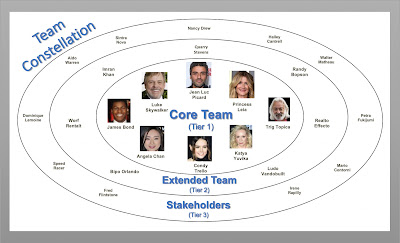
11

Visualizing your Team with the Team Constellation
source link: http://cmforagile.blogspot.com/2020/05/visualizing-your-team.html
Go to the source link to view the article. You can view the picture content, updated content and better typesetting reading experience. If the link is broken, please click the button below to view the snapshot at that time.
Visualizing your Team with the Team Constellation
Your team is real. It is made up of real people that support each other toward common goals. We often get so engrossed in our work that we forget the important connections and relationships across and beyond a team. What really is a team? Emergn defines a team as having a shared purpose, compelling direction, complementary skills, shared responsibilities, and common performance goals. It is important to imprint the team in a visual way. Equally important for a team to visual themselves is for those that support the team to be visually connected.
One way to envision a team is through the visual Team Constellation. The team constellation is a visual way to share who is on the team and who may contribute to the team. The question is how to create the constellation? If you have a team room or area, you can construct one on a white board or on large poster paper, although in either case, I recommend using post-its to represent the people. I’ve had some teams print out small photos of their faces. For distributed teams, you can create a digital online constellation via a number of graphic or illustrative tools and place them on team sites or printed out so they can be shared.
I typically recommend a Team Constellation with three tiers as there are three levels of responsibility that typically are needed to embrace the team’s needs. The first tier includes the core team who are committed to work directly on the product or service and meet the definition of team (in the first paragraph). They provide leadership for each increment, self-organize around the work, build the deliverables, and attend team ceremonies.
The second tier are the extended team that contribute to the team but are not fully committed. They may provide subject matter expertise in a specialized area or a missing temporary skill needed by the team to build the next increment. For work done in an increment, they should participate in any planning, stand-up, or demo related ceremonies.
The third tier are the stakeholders that support and advocate for the team. Those in this tier, have an interest in seeing the team’s work become successful. This will include providing sponsorship in terms of people and resources. They help with communicating progress more broadly and may attend team demos to observe what is being build and may provide feedback. They may also help the team remove roadblocks beyond the team level.
Consider taking time to visualize your team via a team constellation. Take a moment to adapt the definitions of each tier. I suggest making it publicly available so that others understand those that work on and support the team. It can also help you solidify what it really means to be a team.
Consider taking time to visualize your team via a team constellation. Take a moment to adapt the definitions of each tier. I suggest making it publicly available so that others understand those that work on and support the team. It can also help you solidify what it really means to be a team.
Recommend
About Joyk
Aggregate valuable and interesting links.
Joyk means Joy of geeK
